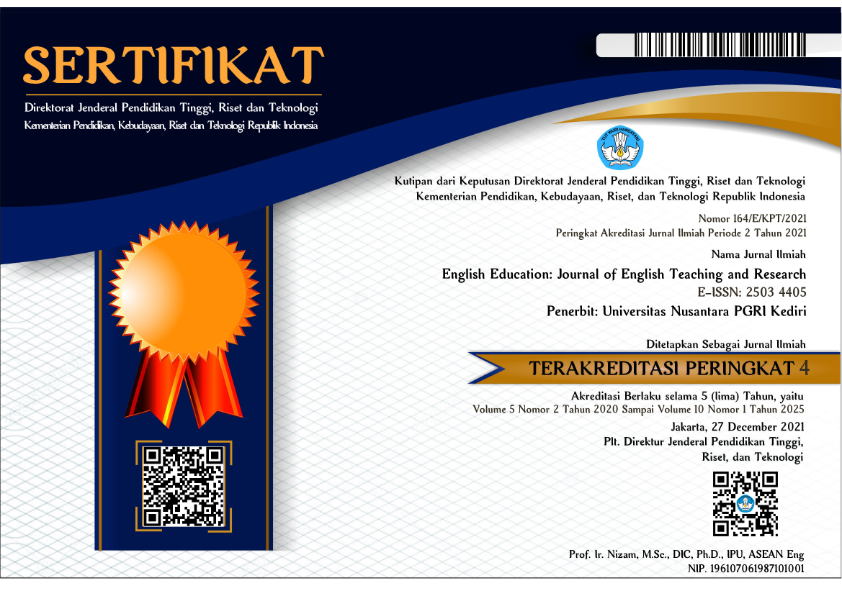Lira’s Personality Development in Alexandra Christo’s To Kill A Kingdom
DOI:
https://doi.org/10.29407/jetar.v10i1.23882Keywords:
close reading, personality change, Hurlock’s determinants, Close reading, Hurlock’s determinants, Personality changeAbstract
This study was to analyze the character growth of a unique character of Lira in Alexandra Christo’s To Kill a Kingdom. It is regarded as a unique character as Lira is not just character. She undergoes a transformation from a rude animal to good human being. Not like the change of character of a man whose changes only from bad to good character without anatomic change, Lira has to face problems to become a good person. Using close reading, the researcher is able to explore deeply the character of Lira before changing and after changing into a human with the result that after taking pains to overcome the problems, Lira is able to change her personality from bad ones: bloodthirsty and obedient (to bad things) to good ones: merciful, disobedient (to bad things), selfless, and noble person. Though the six determinants of Hurlock play important role for the character change, however, the researcher highlights that the more important ones are within somebody himself/herself. Therefore, the six determinants of Hurlock need attention to be more paid because the person plays a role in the world. Thus, the world is a stage within which there are many roles played so that people should be careful to play their roles in this stage.
Downloads
References
Amri, Yasir, Restiono, Danik (2021). Panduan Adab dan Akhlak Harian Seorang Muslim. Ummul Qura.
Asmiaty, MM., Kuncara, SD., Lubis, IS (2022). The Character Development of Isabella Linton in Emily Bronte’s Wuthering Heights. Ilmu Budaya: Jurnal Bahasa, Sastra, Seni dan Budaya, 2 (2), 439-451. URL: https://e-journals.unmul.ac.id/index.php/JBSSB/article/view/5512
Az Zahra, FS., Saktiningrum, N (2019): Anne Shirley’s Character Development and its Causes as Seen in Anne of Green Gables by Lucy Maud Montgomery. LEXICON, 6 (2), 119-132. URL: https://jurnal.ugm.ac.id/lexicon/article/view/53146/26975
Christo, A. (2018). To kill a kingdom. Hot Key Books.
Dabrowski, Kazimierz (2018). PERSONALITY DEVELOPMENT THROUGH POSITIVE DISINTEGRATION. Maurice Bassett
Faraditha, UA., Rezeki, YS., Wardah., Rosnija, E., Surmiyati (2022). An Analysis of The Main Character’s Personality Development in Harry Potter and the Order of the Phoenix. Tamaddun: Jurnal Bahasa, Sastra, dan Budaya, 21 (2), 130-138. URL: https://jurnal.fs.umi.ac.id/index.php/tamaddun-life/article/view/160/168
Hasanah, AN., Natsir, M., Ariani, S (2018). Character Development of Agatha Prenderghast in Cody Kimmel’s Paranorman. Jurnal Ilmu Budaya, 2 (3), 268-275. URL: https://e-journals.unmul.ac.id/index.php/JBSSB/article/view/1156/pdf
Habibah, I., Thoriqussuud, M., Rohman, A., Rohim, F., & Fanani, A. (2023). Quentin’s Personality Development in John Green’s Paper Towns. INTERACTION: Jurnal Pendidikan Bahasa, 10(2), 620-631. https://doi.org/10.36232/jurnalpendidikanbahasa.v10i2.4740
Huberman, et. al. 1984. Innovation Up Close, How School Improvement Works. Massachusetts Institute of Technology.
Hurlock, E. B. (1973). Personality development. 503. https://archive.org/details/personalitydevel0000hurl
Lah, Herni., Supsiadji, MR (2023). Michael Oher’s Personality Development in Michael Lewis’s The Blind Side. UNCOLLCS: Proceeding on Undergraduate Conference on Literature, Linguistics, and Cultural Studies, 1 (1), 1-10. URL: https://conference.untag-sby.ac.id/index.php/uncollcs/article/view/1363
MacAdams, Dan P (2015). The Art and Science of Personality Development. The Guilford Press New York London
MacAdams, Dan P, Shiner, Rebecca L., & Tackett, Jennifer L (2019). Handbook of Personality Development. The Guilford Press New York London
Pickering, S. (2019). Close Reading. In Dreamtime (pp. 92–97). https://doi.org/10.2307/j.ctv6wggx8.14
Sagimin, EM., Damayanti, LN (2019). Interpersonal Relationship and Personality Development on the Main Character in R.J Palacio’s Wonder. Eralingua: Jurnal Pendidikan Bahasa Asing dan Sastra, 3 (1), 10-15. URL: https://ojs.unm.ac.id/eralingua/article/view/8758/5093
Shumate, Carol (2021). Projection and Personality Development via the Eight-Function Model. Routledge.
Shasita, Risky., Hudawinata, Linda (2017). Jason Dixon’s Personality Development as Seen in Martin McDonagh’s Three Billboards Outside Ebbing, Missouri. Cllient: Culture, Literature, Linguistics, and English Teaching, 2 (2), 1-12. URL: https://ojs.unsiq.ac.id/index.php/cllient/article/view/2848/1697
Sitinjak, RG (2021). The Impact of Tony’s Existence to Donald’s Character Development in Green Book Movie. Culturalistics: Journal of Cultural, Literary, and Linguistic Studies, 5 (3), 53-64. URL: https://garuda.kemdikbud.go.id/documents/detail/2441832
Specht, Jule (2017). Personality Development Across the Lifespan. Academic Press.
Sugeha, BU., Mogea, T., Oroh, EZ (2021): Ethan Frome’s Character Development in Wharton’s Ethan Frome. KOMPETENSI: Jurnal Ilmiah Bahasa dan Seni, 1 (2), 302-312. URL: http://ejurnal-mapalus-unima.ac.id/index.php/kompetensi/article/view/1852
Downloads
Published
Issue
Section
License
Copyright (c) 2025 Refa Anafdariska Wibowo, Abu Fanani, Atiq Mohammad Romdlon, Abdur Rohman, Ahmad Frank

This work is licensed under a Creative Commons Attribution-ShareAlike 4.0 International License.
Authors who publish with this journal agree to the following terms:
- Copyright on any article is retained by the author(s).
- The author grants the journal, the right of first publication with the work simultaneously licensed under a Creative Commons Attribution License that allows others to share the work with an acknowledgment of the work’s authorship and initial publication in this journal.
- Authors are able to enter into separate, additional contractual arrangements for the non-exclusive distribution of the journal’s published version of the work (e.g., post it to an institutional repository or publish it in a book), with an acknowledgment of its initial publication in this journal.
- Authors are permitted and encouraged to post their work online (e.g., in institutional repositories or on their website) prior to and during the submission process, as it can lead to productive exchanges, as well as earlier and greater citation of published work.
- The article and any associated published material is distributed under the Creative Commons Attribution-ShareAlike 4.0 International License








 Article template
Article template



